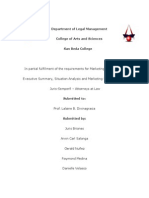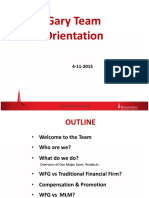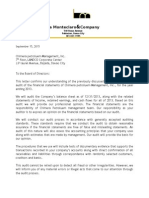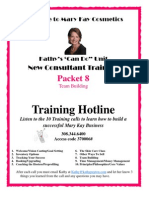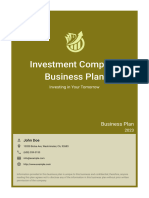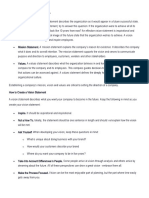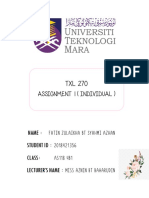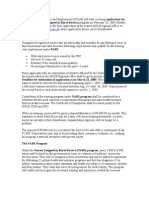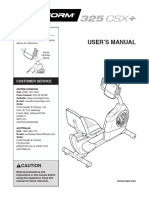How to Write a
Vision Statement
A step by step guide to creating the perfect
vision statement for your organization.
�Table of contents
Overview�������������������������������������������������������������������������������������������������������������������� 3
Getting Started ������������������������������������������������������������������������������������������������������4
Some not so Great Vision Statements (and why)���������������������������������� 6
The Process�������������������������������������������������������������������������������������������������������������� 8
Bringing it all Together����������������������������������������������������������������������������������������11
�How to Write a
Vision Statement
In this eBook we’ll be focusing on the anchor point of our strategic plan
– the vision statement. This is the first step of the process of writing your
strategic plan.
Once done, you’ll be able to move onto writing your values, focus areas
and strategic objectives / organizational goals. Let’s start off by reminding
ourselves of what our end-game looks like in terms of our finished plan:
our vision
value value value
focus area focus area focus area focus area
strategic objective strategic objective
strategic objective
goal goal goal goal goal goal
goal goal goal goal goal goal
3
�Getting Started
Here’s a quick reminder of what we’re trying to achieve with our vision
statement (not everything will apply to every organization, but you’ll get the
gist...)
Creating the pinnacle of the funnel, which every significant action we do
going forward will ultimately be contributing towards.
A memorable and inspirational summary that describes our reason for
existence as an organization – one that will help to motivate existing
employees and even attract high quality new ones.
A succinct statement about what our organization is trying to achieve to
help third parties such as investors or the media better understand us.
A ‘limiter’ that helps us to rule out certain opportunities which do not
ultimately contribute to our vision.
Something that you and the other senior members of the organization
passionately believe in and want to achieve.
There are a few common rules that pretty much all good vision statements
should follow:
1. They should be short – two sentences at an absolute maximum. It’s fine
to expand on your vision statement with more detail, but you need a
version that is punchy and easily memorable.
2. They need to be specific to your business and describe a unique
outcome that only you can provide. Generic vision statements that could
apply to any organization won’t cut it (see our examples below for more
on this point).
3. Do not use words that are open to interpretation. For example, saying you
will ‘maximise shareholder return’ doesn’t actually mean anything unless
you specify what it actually looks like.
4. Keep it simple enough for people inside and outside the organization to
understand. No technical jargon, no metaphors, no business buzz-words!
4
�5. It should be ambitious enough to be exciting but not too ambitious that it
seems unachievable. It’s not really a matter of time-framing your vision,
because that will vary by organization, but certainly anything that has a
timeframe outside of 3 to 10 years should be challenged as to whether
it’s appropriate.
6. It needs to align to the Values that you want your people to exhibit as
they perform their work. We’ll talk more about Values in a future eBook –
but once you’ve created those Values later on, revisit your vision to see
how well they gel.
Following these rules should give you a pretty good starting point for
creating your own vision statement. To help refine things further, we’ll now
look at some examples of vision statements that did not follow these rules...
5
�Some not so Great Vision
Statements (and why)
Here are some examples of real-life vision statements that in our opinion,
could do with a little tweaking. For each one, we’ll try to justify our thinking...
“Our company vision is to make every brand
more inspiring and the world more intelligent.”
Well, this one gets a tick on the ‘ambitious’ test if nothing else. But.....is it
realistic that ‘every brand’ will use the services of this company? How about
‘making the world more intelligent.’ – let’s try to quantify what that might
actually look like. Or let’s not. Because it’s impossible. Not to be too harsh
though – there are strong elements here; ‘making brands more inspiring’
makes a lot of sense and has some depth.
“Provide maximum value for our shareholders
whilst helping our customers to fulfil their dreams.”
This ‘vision’ could pretty much apply to any company, anywhere (it’s an
insurance company in this case – but would you have guessed that?). It’s
sort of like saying ‘Our vision is to succeed as a business’. Not wrong – but
certainly not inspiring or unique.
Last one...
“We are committed to achieving new standards
of excellence by providing superior human capital
management services and maximizing the potential of
all stakeholders – clients, candidates and employees –
through the delivery of the most reliable, responsive....
[and it goes on, but that’s probably enough]...”
6
�It would be quite hard to write a vision statement filled with less tangibility
and more subjectivity that this one. ‘New standards of excellence’. ‘Superior
human capital management’. ‘Maximising the potential’. There are simply
far too many buzz words, intangibles and vaguery here for this to be either
memorable or inspiring.
We are of course being rather harsh. But hopefully the above examples
illustrate well some of the pitfalls to avoid when creating your own vision.
7
�The Process
There are literally hundreds of articles out there that will give you examples
of good and bad vision statements as well as a high-level overview of what
to consider when creating your own. But what we noticed was lacking was
a concrete process to go through to help you create one. As such, we’ve
outlined a process that we have used with clients in Cascade that might
work for you too.
Step 1: Define what you do as an output
Start by being exceptionally clear about what it is your organization actually
does. Be careful to remain ‘output focused’ rather than ‘input focused’.
For example, Microsoft famously had a vision statement to Put a Microsoft
powered computer on every desk in the world (slightly paraphrased).
Strictly speaking what Microsoft ‘do’ is make computer software, but for the
purposes of their vision, they looked forward to the actual outcome of this
process – i.e. computers on desks.
A bakery makes bread. But the outcome is consumers enjoying
that bread.
A consulting company gives advice. But the outcome is the success of
others based on that advice.
A government department does...lots of things. But the outcome is better
lives for the citizens they serve.
Whilst this process may seem obvious – you would be surprised by how
rarely organizations actually go through this process in a formal, written
way. Doing so will take you a long way towards creating your vision
statement – BUT it’s not enough alone! If it was, all bakeries for example
would have the same vision statement – which is hardly inspiring!
8
�Step 2: Define what unique twist your
organization brings to the outcome
Very few products or services these days are truly new – most are more like
reinventions of something that exists already, but with a different approach,
focus or spin.
At some point in your organization’s lifespan – someone will have believed
that the reason that THIS organization would be successful where others
have failed, was because of.........something.
You need to define that something!
Let’s take our bakery example. So far, our vision statement is looking pretty
generic, along the lines of customers enjoying our bread. But why will
they enjoy our bread MORE than the bread from the place next door? Is it
because we use centuries old traditions passed through generations of
our family?
Because we only use premium grade locally sourced ingredients? Whatever
your unique selling point is – let it shine through in your vision statement.
Step 3: Apply some high-level quantification
A common problem with vision statements is ironically, that they are too
visionary! With no possible end in sight (or a totally unrealistic one) – the
initial inspiration derived from a great vision statement can quickly turn to
frustration, or even cynicism among employees and customers.
That said – don’t be too specific or apply specific metrics at this stage (they
will come later in our planning process).
Sticking with our bakery example – we might want to refine our target
audience to ‘every customer who walks through the door’ – that’s fine, or
maybe we want to be bolder: ‘every customer within walking distance of
a store’.
The quantification we apply could also be industry specific if you’re a B2B –
are you shooting for SMEs or multinationals for example?
9
�Step 4: Add relatable, human, ‘real world’ aspects
OK, your vision by this point should be getting pretty close to being finished.
But one final trick you can apply to help make it even more memorable is to
add a real-life aspect so that people can conjure up a solid mental image
to associate with your vision statement. Let’s look at an example – which of
the following statements is likely to be more memorable:
a) To have every working person in the world using Microsoft product. Or....
. b) A Microsoft powered computer on every desk.
I would argue that (b) is more memorable, because as I read this, I’m
actually visualising a computer (in my case) sitting on a wooden desk in
a room. There’s nothing wrong with (a) but it’s highly conceptual and thus
difficult to transform into a mental picture. Let’s look at another example:
Ensure that every customer who leaves our store, does so smiling.
Here, using the word ‘smiling’ as apposed to ‘happy’ is powerful, because it
conjures a mental image of a person smiling.
It won’t always be possible to bring this level of tangibility to your vision
statement – but if it is, I would strongly encourage doing so.
10
�Bringing it all Together
Let’s finish off with a look at what a completed vision statement could look
like for our bakery, based on the above:
Producing and selling locally sourced cakes and pies that are so delicious
and satisfying, that every customer who leaves our store does so with a
smile.
If we deconstruct this into our various steps, we can see each at work as
follows:
Producing and selling locally sourced cakes and pies that are so delicious
and satisfying, that every customer who leaves our store does so with
a smile.
Step 1: The output
Step 2: The twist
Step 3: The quantification
Step 4: The human connection
There are other ways to construct great vision statements – and even if
yours ends up looking a little different, following this simple process will help
you to create powerful, punchy vision statements that will stand the test
of time.
11
�Wasn’t that
insightful?
If you are excited to start creating and
executing your strategy, Cascade can
help you on your way.
Book a demo with our team of strategy
experts today.
Book a Demo Learn about Cascade





















